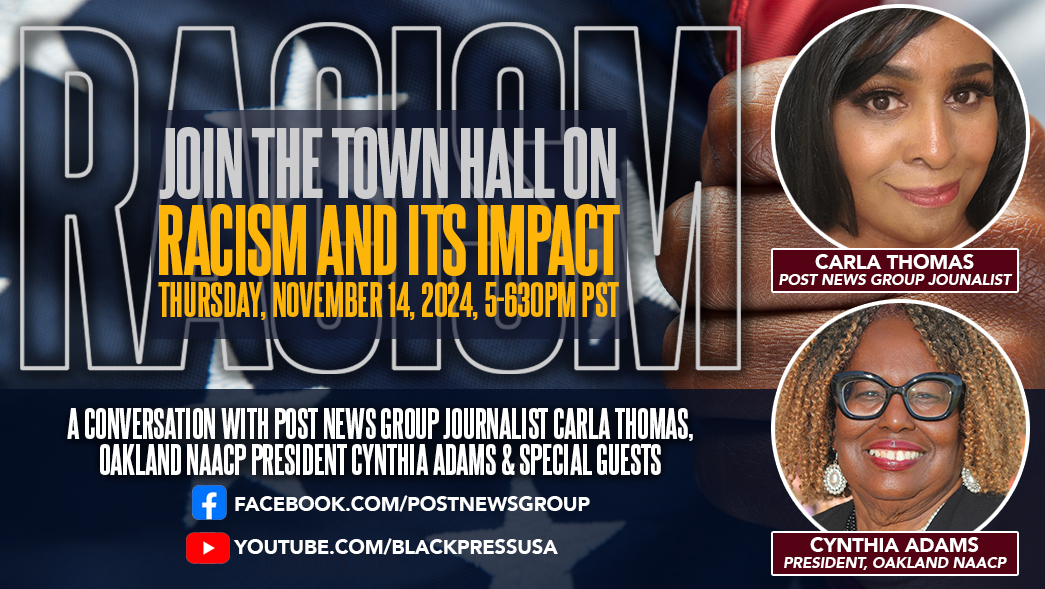Activism
California Latino Legislative Caucus Celebrates 50th Anniversary
“The issues that are bringing us together as Latinos are California issues, whether it’s housing insecurity and affordability, looking at just the economic disparities that exist,” said Sabrina Cervantes (D-Riverside), the first LGBTQ+ leader and chair of the CLLC. “These are all issues that have continued to be a priority for our caucus and issues that many of our members fight on.”

By Solomon O. Smith | California Black Media
The California Latino Legislative Caucus (CLLC) celebrated its 50th anniversary with a black-tie event at the Orpheum Theatre in downtown Los Angeles last Friday. The event was a retrospective awards ceremony, honoring the achievements of the caucus over the past five decades.
Initially known as the Chicano Legislative Caucus, the CLLC was made up of five male Latino members: Alex Garcia, Peter Chacon, Joseph Montoya, Ray Gonzales and Richard Alatorre, according to their history page.
Today, under the leadership of Sabrina Cervantes (D-Riverside), the first LGBTQ+ leader and chair of the CLLC, the caucus boasts 38 members, with a majority of 21 Latinas. Cervantes recognized the significant expansion of the caucus over the past 50 years.
“The issues that are bringing us together as Latinos are California issues, whether it’s housing insecurity and affordability, looking at just the economic disparities that exist,” said Cervantes. “These are all issues that have continued to be a priority for our caucus and issues that many of our members fight on.”
Martha Escutia, the first woman to chair the CLLC and a former member of the California Senate and Assembly with over 16 years in politics was featured in a short film played at the celebration. The film, narrated by Lin-Manuel Miranda, the writer and star of “Hamilton,” traced the 50-year history of the caucus.
Escutia considered the 1980 reapportionment which allowed for greater representation of the Latino community, as a key turning point. While she takes pride in the caucus’ accomplishments, she believes there is still more to be achieved.
“The problems are still the same: lack of housing, lack of economic sustainability for families, just even building a safety net for families,” said Escutia. “It’s still an issue that bedevils, frankly, all caucuses because I think, the Black Caucus also has the same concerns, as well as even the Asian American-Pacific Islander caucus.”
Hilda Solis, who is supervisor for the First District, Los Angeles County, presented a congratulatory document from the Los Angeles County Board of Supervisors at the red-carpet event to Cervantes and the caucus’ vice chair, California State Senator Lena Gonzalez.
Solis, a former member of the California Assembly and Senate, is the first Latina to serve in a presidential Cabinet as U.S. Secretary of Labor.
The evening’s speakers were some of the most accomplished artists, actors, politicians, and public servants in the Latino community.
The Masters of Ceremonies for the event were Tony Plana, an activist, director, and actor known for his role in “Ugly Betty” and Justina Mochado, an actor and producer, known for her performance in the series, “The Horrors of Delores Roach,” and “One Day at a Time.”
Xavier Becerra, the 25th Secretary of the Department of Health and Human Services, was the keynote speaker. His rise through the ranks of the California legislative system has been a testament to overcoming obstacles.
He began his political career in the California state assembly, progressed to the U.S. House of Representatives, and then served as the 33rd attorney general of California, before assuming his current position under President Joe Biden. He talked about how far the state, and the caucus, have come saying “so goes the caucus, so goes the state of California.”
The evening’s celebrations were not just about the caucus’s legislative achievements. The awards also acknowledged the efforts made by and for the Hispanic community. Poets Yesika Salgado and Yosimar Reyes performed a poem that encapsulated the experiences of young Latino immigrants.
The event also featured a segment dedicated to giving back. Sixty-one students from across the state took to the stage to express their gratitude to the caucus for their support of higher education. The California Latino Legislative Caucus Foundation gave $5,000 to each student who represented different regions across the state.
The evening concluded with the presentation of the Legacy Award to multiple organizations. The recipients included the Mexican American Legal Defense Fund, accepted by Thomas Saenz; the United Farm Workers, received by Teresa Romero; and the California Rural Legal Assistance, accepted by Jessica Jewell.
Musical and special performances were spread throughout the show. The band Quitapenas, Jesse Garcia, and others celebrated and performed. The evening ended with a musical performance by music legend Andy Vargas and his band. Vargas is a beloved member of Santana and a giant in the Latin music scene.
According to CLLC vice chair, Sen. Lena Gonzalez (D-Long Beach), the future of the caucus hinges on its capacity to advance legislation and advocate for an inclusive agenda.
“We’ll continue to fight to make sure that our voices are heard along with our brothers and sisters in the Black Caucus, API caucus and LGBTQ caucus,” said Gonzalez. “It’s a collective for all of us to be a part of, and when we push together, I think we’re more unified. Looking at next year to think about how we can partner up with our other ethnic caucuses.”
Activism
An Inside Look into How San Francisco Analyzes Homeless Encampments
Dozens of unhoused people are camped at Sixth and Jesse streets in San Francisco’s South of Market neighborhood. Tents made of tarps and blankets, piles of debris, and people lounging alongside the allies and walls of businesses are seen from all angles. These are some of the city’s hotspots. City crews have cleared encampments there over 30 times in the past year, but unhoused people always return.

By Magaly Muñoz
Dozens of unhoused people are camped at Sixth and Jesse streets in San Francisco’s South of Market neighborhood. Tents made of tarps and blankets, piles of debris, and people lounging alongside the allies and walls of businesses are seen from all angles.
These are some of the city’s hotspots. City crews have cleared encampments there over 30 times in the past year, but unhoused people always return.
But it’s normal to have tents set up again within less than 24 hours after an encampment sweep, David Nakanishi, Healthy Streets Operation Center Manager at the Department of Emergency Management, says. Sometimes there’s less people than before but often there is also no change.
“Most of the people that were in the encampments that want to go inside, we’ve gotten the majority of those [into shelter],” Nakanishi says. “Many of the people we encounter now, are those who have various reasons to not accept shelter, and some are already in shelter/housing”.
Since the ruling of Grants Pass by the US Supreme Court earlier this summer, which allows cities the authority to ban people from camping or sleeping on the streets, San Francisco has been at the head of the conversation to crack down on encampments.
Where neighboring cities in the Bay Area are clearing encampments a few days a week, San Francisco is sweeping 10 times a week, two per weekday.

David Nakanishi, Healthy Streets Operation Center Manager at the San Francisco Department of Emergency Management, makes a 311 report on an encampment in the Mission District. These reports allow smaller city teams to tackle individual spots where unhoused people frequent. Photo by Magaly Muñoz.
Considering the controversy that plagues the city around its harsh policies, the Post decided to tag along on a ride with Nakanishi to show us how he decides what encampments make it on the city’s sweep list.
Nakanishi, having over 20 years of experience in homelessness management, drives around the busiest parts of the city almost daily. He’s tasked with arranging a weekly sweeping operation schedule for city teams to engage with unhoused folks to help get them off the streets.
So what exactly is he looking out for when deciding what encampments get swept?
It depends, he says.
Locations like schools, recreational centers, senior centers, or businesses are places he tends to want to address quickly, especially schools. These are the places where the complaints are highest and access to facilities is important for residents.
He says he also takes into account 311 calls and reports made to him by city staff. On the date of publication, over 100 calls and reports were made about encampments around the city, according to San Francisco data.

Makeshift structures built from plywood and tarps are starting to pop up more throughout the city. Certain areas under freeways are not under direct authority from San Francisco, making it harder to sweep these encampments. Photo by Magaly Muñoz.
Nakanishi made a few 311 reports himself on the ride along, pulling over to take photos and describe the encampments into his 311 app. He says it helps him remember where to possibly sweep next or allows smaller teams in the city to engage quicker with individuals on the streets.
Nakanishi also looks at the state of the encampments. Are there a lot of bulky items, such as furniture, or makeshift structures built out of tarps and plywood, blocking areas of traffic? Is trash beginning to pile up and spill into the streets or sidewalks? Sites that meet this criteria tend to be contenders for encampment sweeps, Nakanishi says.
Street by street, he points out individuals he’s interacted with, describing their conditions, habits, and reasons for denying assistance from the city.
One man on 2nd St and Mission, who rolls around a blue recycling bin and often yells at passing pedestrians, has refused shelter several times, Nakanishi says.
People deny shelter for all kinds of reasons, he says. There’s too many rules to follow, people feel unsafe in congregate or shared shelters, or their behavioral and mental health problems make it hard to get them into proper services.

Inside a tent left by an unhoused man on Stevenson and 14th Street in San Francisco. The area smelled of human waste and leftover alcohol. Photo by Magaly Muñoz.
Nakanishi references another man on South Van Ness under the freeway, who city outreach have attempted to get into shelter, but his screaming outbursts make it difficult to place him without disturbing other people in the same space. Nakanishi says it might be an issue of the man needing resources like medication to alleviate his distress that causes the screaming, but the city behavioral team is in the process of outreaching him to figure that out.
In October, city outreach teams engaged with 495 unhoused people. 377 of those engaged refused shelter and only 118 accepted placements, according to city data. That number of monthly referrals is consistent throughout the entirety of 2024 so far.
Nakanishi has long advocated for the well-being of unhoused people, he explains. In 2004, he was working with the Department of Public Health and told then-Mayor Gavin Newsom that there needed to be more housing for families. Nakinishi was told it was easier to deal with individuals first and the city “will get there eventually.” 20 years later, family housing is still not as extensive as it could be, and the waiting list to get placements for families is a mile long with over 500 names.
In 2020, he was a Senior Behavioral Health Clinician at a hotel in the city during the pandemic. He says in 2021 he collaborated with DPH to provide vaccines to those staying in the makeshift hotel shelters once those became available.

Nakanishi strips apart a solo tent on Stevenson and 14th Street in San Francisco. He discards items, like tarps and cardboard, so that people cannot reuse them to make another sleeping structure. Photo by Magaly Muñoz.
Despite the constant media attention that city outreach is inhumanely treating homeless people, so much so that it has led to lawsuits against San Francisco from advocates, Nakanishi says not a lot of people are seeing the true conditions of some encampments.
He describes soiled clothing and tents, drenched in urine, and oftentimes rodents or bug infestations in places where people are sleeping. He’s asked homeless advocates- often those who are the most critical about the city’s work- who have shown up to observe the sweeps if those are conditions the city should allow people to be subjected to, but not many have answers for him, Nakanishi says.
The city’s “bag and tag” policy allows city workers to throw away items that are “soiled by infectious materials” such as bodily fluids and waste.
Sweep operations are conducted at 8am and 1pm Monday through Friday. People at the encampments are given 72 hour notice to vacate, but some don’t leave the area until the day of the sweep.
City outreach workers come out the day before and day of to offer resources and shelter to those interested. The Department of Public Works discards any trash that is left over from the sweep and washes down the area.
Nakanishi told the Post that the only time the city takes tents or personal possessions from residents is when folks become physically violent towards workers and police take the items as evidence. Other items taken are bagged and tagged in accordance with city policy.
Stories from local newspapers such as the San Francisco Standard and the Chronicle show instances of SFPD handcuffing residents while their items are thrown in the trash or disposing of personal possessions without reason.
Advocates have long been pushing for a more competent and compassionate process if the city is going to choose to continue sweeping unhouse people.
No matter the lawsuits and constant criticisms from allies, the encampment sweeps are not slowing down, even with the cold weather quickly approaching the coastal city.
Nakanishi says there aren’t a lot of large encampments left in San Francisco so now they do runs of streets in order to stretch out the sweeps as much as possible.
It’s calculated strategies and years of first hand knowledge that make this job work, “It takes dedication to the work, caring for the people and the community, and persistence, patience and sometimes good luck to make the positive changes for the people on the street,” Nakanishi says.
Activism
Oakland Post: Week of November 13 – 19, 2024
The printed Weekly Edition of the Oakland Post: Week of November 13 – 19, 2024

To enlarge your view of this issue, use the slider, magnifying glass icon or full page icon in the lower right corner of the browser window. ![]()
Activism
LIVE! — TOWN HALL ON RACISM AND ITS IMPACT — THURS. 11.14.24 5PM PST
Join us for a LIVE Virtual Town Hall on the Impact of Racism hosted by Post News Group Journalist Carla Thomas and featuring Oakland, CA NAACP President Cynthia Adams & other Special Guests.
Thursday, November 14, 2024, 5 p.m. – 6:30 p.m. PST

Join us for a LIVE Virtual Town Hall on the Impact of Racism hosted by Post News Group Journalist Carla Thomas and featuring Oakland, CA NAACP President Cynthia Adams & other Special Guests.
Thursday, November 14, 2024
5 p.m. – 6:30 p.m. PST
Discussion Topics:
• Since the pandemic, what battles have the NAACP fought nationally, and how have they impacted us locally?
• What trends are you seeing concerning Racism? Is it more covert or overt?
• What are the top 5 issues resulting from racism in our communities?
• How do racial and other types of discrimination impact local communities?
• What are the most effective ways our community can combat racism and hate?
Your questions and comments will be shared LIVE with the moderators and viewers during the broadcast.
STREAMED LIVE!
FACEBOOK: facebook.com/PostNewsGroup
YOUTUBE: youtube.com/blackpressusatv
X: twitter.com/blackpressusa
-

 Alameda County4 weeks ago
Alameda County4 weeks agoAlameda County District Attorney Pamela Price Announces $7.5 Million Settlement Agreement with Walmart
-

 Activism3 weeks ago
Activism3 weeks ago‘Jim Crow Was and Remains Real in Alameda County (and) It Is What We Are Challenging and Trying to Fix Every Day,’ Says D.A. Pamela Price
-

 Bay Area3 weeks ago
Bay Area3 weeks agoIn the City Attorney Race, Ryan Richardson Is Better for Oakland
-

 Activism3 weeks ago
Activism3 weeks agoOakland Post: Week of October 30 – November 5, 2024
-

 Alameda County3 weeks ago
Alameda County3 weeks agoD.A. Price Charges Coliseum Flea Market Vendors in Organized Retail Theft Case
-

 Activism3 weeks ago
Activism3 weeks ago‘Criminal Justice Reform Is the Signature Civil Rights Issue of Our Time,’ says D.A. Pamela Price
-

 Activism3 weeks ago
Activism3 weeks ago“Two things can be true at once.” An Afro-Latina Voter Weighs in on Identity and Politics
-

 Arts and Culture3 weeks ago
Arts and Culture3 weeks agoMacArthur Fellow Jericho Brown’s Poetry Reflects Contemporary Culture and Identity
















































